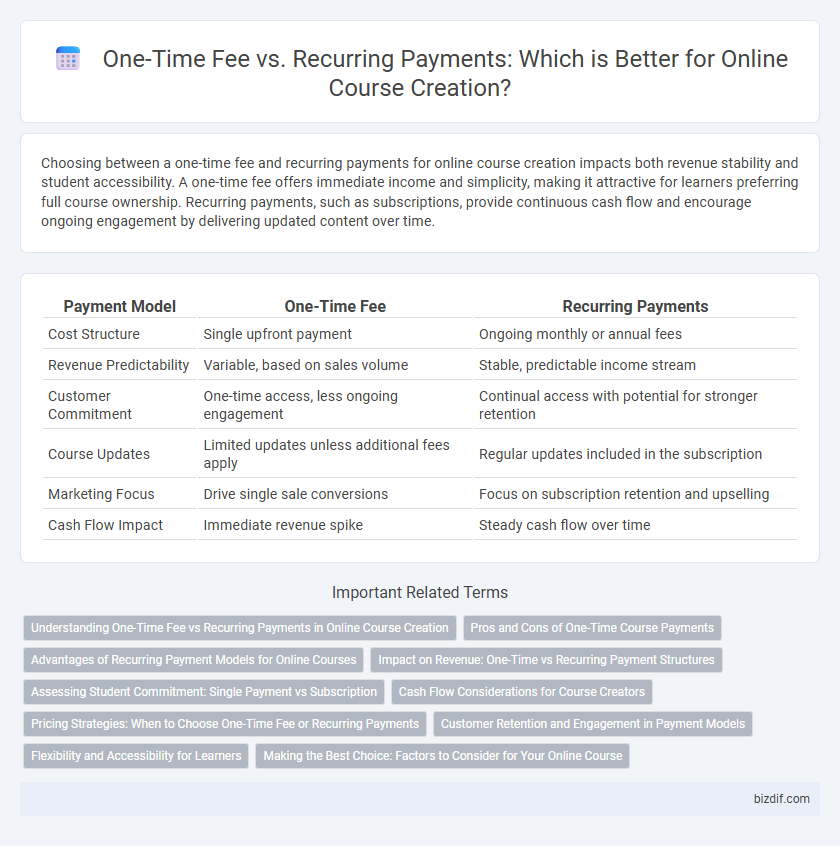Choosing between a one-time fee and recurring payments for online course creation impacts both revenue stability and student accessibility. A one-time fee offers immediate income and simplicity, making it attractive for learners preferring full course ownership. Recurring payments, such as subscriptions, provide continuous cash flow and encourage ongoing engagement by delivering updated content over time.
Table of Comparison
| Payment Model | One-Time Fee | Recurring Payments |
|---|---|---|
| Cost Structure | Single upfront payment | Ongoing monthly or annual fees |
| Revenue Predictability | Variable, based on sales volume | Stable, predictable income stream |
| Customer Commitment | One-time access, less ongoing engagement | Continual access with potential for stronger retention |
| Course Updates | Limited updates unless additional fees apply | Regular updates included in the subscription |
| Marketing Focus | Drive single sale conversions | Focus on subscription retention and upselling |
| Cash Flow Impact | Immediate revenue spike | Steady cash flow over time |
Understanding One-Time Fee vs Recurring Payments in Online Course Creation
One-time fees in online course creation provide learners with full access through a single payment, simplifying budgeting and increasing perceived value. Recurring payments generate steady revenue streams for creators, enabling continuous content updates and ongoing support for students. Choosing between these models depends on course length, content delivery frequency, and target audience preferences for payment flexibility.
Pros and Cons of One-Time Course Payments
One-time course payments offer simplicity and clear budgeting for both creators and students, eliminating the uncertainty of ongoing charges, which can enhance user satisfaction and reduce churn rates. This payment model provides immediate revenue influx, allowing course creators to quickly reinvest in content improvement, but it may limit long-term income potential compared to subscription models. On the downside, one-time fees can reduce engagement incentives, as students might feel less compelled to complete the course promptly without recurring payment motivations.
Advantages of Recurring Payment Models for Online Courses
Recurring payment models for online courses ensure a steady and predictable revenue stream, facilitating better financial planning and growth. They enhance customer retention by encouraging continuous engagement and providing ongoing access to updated content or exclusive benefits. This subscription-based approach fosters a loyal community, increases lifetime customer value, and reduces churn compared to one-time fee structures.
Impact on Revenue: One-Time vs Recurring Payment Structures
One-time fee models generate immediate revenue but limit long-term income potential, often requiring continuous new customer acquisition to sustain cash flow. Recurring payment structures, such as subscriptions or memberships, create predictable, stable revenue streams and increase customer lifetime value through ongoing engagement. Maintaining a recurring payment model enhances financial growth by fostering customer loyalty and reducing reliance on frequent sales cycles.
Assessing Student Commitment: Single Payment vs Subscription
A one-time fee for online courses often encourages greater student commitment through full access upfront, reducing distractions caused by ongoing payment decisions. Conversely, recurring subscription models can lower initial barriers, attracting more students but may risk higher churn rates as continued payments require sustained motivation. Evaluating student engagement patterns reveals that single payments foster long-term course completion, while subscriptions suit learners preferring flexible, short-term access.
Cash Flow Considerations for Course Creators
One-time fees provide immediate revenue influx, enabling course creators to cover upfront production costs quickly and invest in marketing or content improvements. Recurring payments generate steady, predictable cash flow that supports ongoing expenses such as platform fees, customer support, and content updates. Balancing these payment models allows creators to optimize financial stability and long-term growth potential in the competitive online course market.
Pricing Strategies: When to Choose One-Time Fee or Recurring Payments
Choosing between a one-time fee and recurring payments depends on course content longevity and target audience engagement; one-time fees suit evergreen courses with comprehensive content, while recurring payments work best for ongoing, updated programs or membership-based learning. Pricing strategies should consider cash flow needs and customer lifetime value; recurring models generate stable revenue streams, whereas one-time fees provide immediate income but limited long-term earnings. Analyzing competitor pricing and student retention rates aids in deciding the optimal payment structure to maximize profitability and course accessibility.
Customer Retention and Engagement in Payment Models
One-time fee payment models provide immediate revenue but often struggle to maintain long-term customer retention and engagement, as learners may lack motivation to continue after initial access. Recurring payment models, such as subscriptions, foster ongoing commitment, encouraging continuous interaction with course content and higher lifetime value per user. Studies indicate subscription-based learners show 30% greater engagement rates and 25% longer retention periods compared to one-time fee users.
Flexibility and Accessibility for Learners
One-time fee models provide learners with unlimited access to course materials without ongoing charges, enhancing accessibility for those with limited budgets. Recurring payments offer flexibility by allowing learners to pay in smaller, manageable installments, accommodating varying financial situations and encouraging longer engagement. Both payment structures impact learner retention and accessibility differently, depending on individual preferences and financial capabilities.
Making the Best Choice: Factors to Consider for Your Online Course
Choosing between a one-time fee and recurring payments for your online course depends on factors such as revenue stability, customer retention, and course content updates. One-time fees provide immediate income but may limit long-term profitability, while recurring payments generate consistent cash flow and foster ongoing student engagement. Assess your course's value proposition, target audience preferences, and content delivery model to determine the most effective pricing strategy.
One-time fee vs Recurring payments Infographic

 bizdif.com
bizdif.com